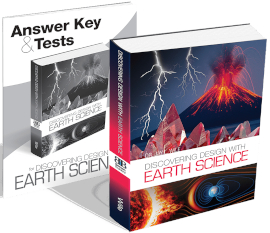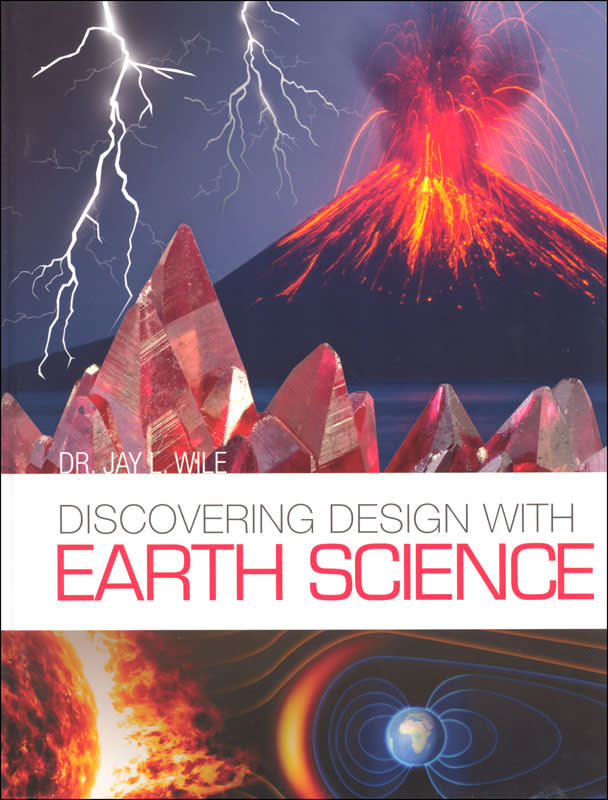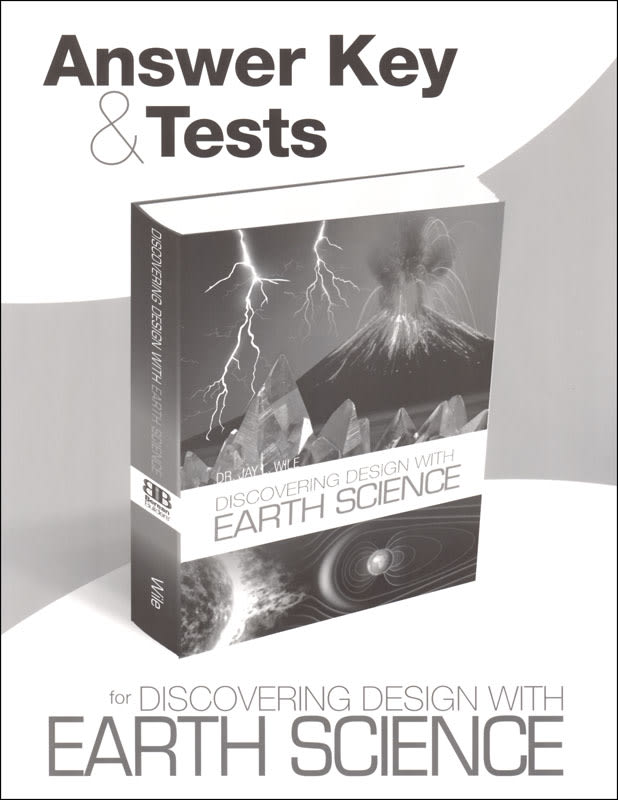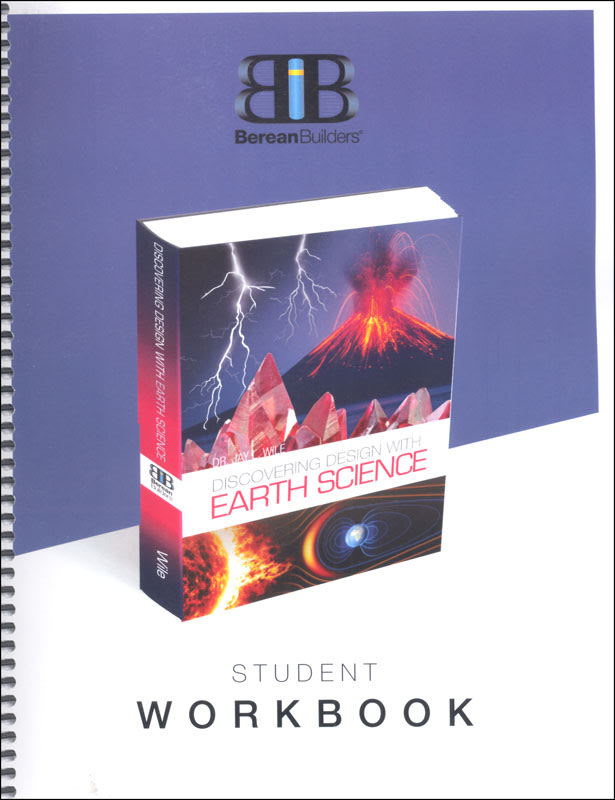Discovering Design with Earth Science is a complete course, including labs, that can be used by high school students. However, it is written at such an understandable level that it might also be used by eighth-graders. Author Dr. Jay Wile writes in a conversational style, often bringing in practical applications or observations that make the content much more interesting to read than you might expect.
The course is written for Christian students with scripture verses, occasional references to God, and an underlying Christian worldview. While Dr. Wile’s viewpoint is that of a young-earth creationist, he does a credible job of explaining other viewpoints regarding the age of the earth. He primarily contrasts young-earth and old-earth positions, acknowledging that Christians align on both sides of the question and at nuanced positions in between. For a number of topics (e.g., radiometric dating), he points out the strengths and weaknesses of opposing positions. This is an aspect of the course that makes it superior to some courses from other Christian publishers that present and defend only one position.
The course consists of a hardcover, 542-page textbook, a lab kit, and an Answer Key & Tests book. An optional thumb drive has an audio version of the textbook as mp3 files. The audiobook does not replace the textbook since students still need to look at the illustrations, labs, and questions in the textbook. You also might want to print out the free, 238-page Student Workbook PDF, which I describe below. (A printed Student Workbook is available from Christianbook.com.)
The textbook has 16 chapters, and it should take students about two weeks to complete all of the work associated with each chapter. Lab activities are presented within the textbook, with one to five activities per chapter. Students are expected to stop and do them at the points where they appear. Generally, there is less text to read for the days when there is a lab activity.
Comprehension Checks appear in pale yellow boxes at the end of each day’s reading (and sometimes lab work). Comprehension Checks present students with one to four questions to answer. Students might use the Student Notebook (PDF), a blank notebook, or a computer (as a writing and storage device) for answering the questions. The first 110 pages of the Student Notebook have both the Comprehension Check questions and the Chapter Review questions followed by sufficient space for students to write their answers. The answers for each chapter’s Comprehension Check questions are included within the textbook right before the Chapter Review so that students can check themselves. The Comprehension Checks are not quizzes but are designed for students to self-check and review to ensure that they understand the information.
At the end of each chapter, a Chapter Review serves as a quiz to ensure that students have understood and retained the information. Again, students can write their answers in the Student Notebook, in another notebook, or on a computer. Answer keys for the Chapter Reviews are in the Answer Key & Tests book.
Once the Chapter Review has been checked and students have reviewed any questions they answered incorrectly, they are ready to take the Chapter Test. You will almost certainly want to photocopy the tests from the Answer Key & Tests book since answer key pages are frequently on the reverse side of the final page of the tests. (Permission to copy the tests is given.) There are no mid-term or final exams.
The course is very logically organized with chapters building upon one another. The first chapter, titled “Basic Concepts Required to Study Earth Science,” covers some basic chemistry, the math involved in the study of science at this level, units of measurement and conversions, and other preliminary topics. The other chapters cover the earth’s crust, minerals, rocks, the lithosphere, motion in the lithosphere, fossils, the geological record, uniformitarianism versus catastrophism, water, the hydrosphere, the atmosphere, weather, the solar system, and the universe. While there is an entire chapter on uniformitarianism and catastrophism, the topic is actually introduced in the second chapter and revisited frequently since it has such a strong bearing on how different scientists interpret geological evidence from these two contrasting points of view.
Supplemental course material is available online at no extra cost. The supplemental material is presented for each chapter, and it consists almost entirely of videos, many on YouTube®.
Lab Work
Students need to use the lab kit that was created for this course. It contains a set of rocks and minerals, fossil specimens, sediment specimens, a digital mass scale, a magnifying glass, chemicals such as a hydrochloric acid solution and hydrogen peroxide, a graduated cylinder, pH paper, and many other items. Some rock and mineral specimens are identified only by numbers in this kit, and students will work on their identification in some of the labs. Because of the numbered specimens, you cannot substitute another kit.
For many of the experiments, Dr. Wile has students create makeshift lab equipment rather than having to obtain specialized scientific equipment. For instance, they will use modeling clay or Play-Doh® to seal the top of a plastic drink bottle around a straw (p. 358). The few specialized items required are in the kit. Otherwise, household supplies are used.
Each lab is presented in a light blue square on one or more pages. The labs stand out from the rest of the text, so students can easily spot them. Immediately following each lab in the textbook, Dr. Wile goes on to discuss the results within the text for the rest of that day’s lesson. It won’t work to save the experiments for later (or to be done with a group class), since they need to be done at the point in the textbook where they are inserted.
A list of required supplies is at the top of each lab. Students are given a heads-up in the preceding Comprehension Check if advanced planning for the lab is required. The step-by-step instructions are very thorough, including concluding instructions to “clean up your mess.”
Before doing their first lab, students need to learn how Dr. Wile wants them to record their lab work. They need to go to the dedicated area of the publisher’s website where they will find PDFs that tell them how to do this, along with samples of lab documentation. Students will record brief notes on the procedure and data (both observations and measurements) while doing each lab, then write a summary and conclusion. The Student Notebook has a few pages that tell students how to write up their lab work, but the remaining pages in the notebook are essentially blank pages for writing up labs. Some students might prefer writing on lined paper or creating their lab notebook in some other fashion, so they can do it in whatever way works best for them.
Dr. Wile notes that the experiments are no more dangerous than cooking or cleaning, but they should still be supervised by an adult. I expect that most students will complete the lab activities mostly on their own.
Summary
Discovering Design with Earth Science provides solid coverage of earth science through both the text and the experiments. It is an outstanding course that should be interesting and easy for students to use.












